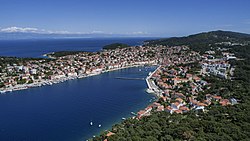|
Mali Lošinj
Mali Lošinj (Italian: Lussinpiccolo, Venetian: Lusinpicolo) is a town in the Primorje-Gorski Kotar County, on the island of Lošinj, in western Croatia. At the time of the 2021 census, there were 7,537 inhabitants, of whom 86% were Croats. The town of Mali Lošinj itself had an urban population of 5,561.[2] The favourable climatic conditions, the construction of hotels and resorts, foresting, and maintenance of beaches have led to the intensive development of tourism. The town is located in the most protected part of the Lošinj bay, on the eastern, sunny side of the island. The asteroid 10415 Mali Lošinj is named after this town.[3] History The town was first mentioned in 1398, under the name Malo selo ("small village"). In 1868, it experienced its golden year. There were as many as eleven shipyards, and it became the place with the largest and most developed merchant marine in the Adriatic Sea, even ahead of cities like Rijeka, Trieste and Venice.[citation needed][dubious – discuss] American author Kenneth Roberts observed that the little town, like some in southern Maine, seemed to have "produced a hundred seamen for each one produced elsewhere." Writing in 1938, Roberts said there were currently "four hundred sea captains living on Lussinpiccolo, which is about the size of Monhegan Island- captains of all sorts of vessels, from thirty thousand ton liners to hundred ton merchant brigs."[4] With the invention of the steam engine a stagnation in development ensued, and with the outbreak of the grapevine disease peronospora. Previously part of the Venetian Republic, Mali Lošinj passed under Austrian-Hungarian rule in 1797 with the Treaty of Campo Formio. The isle remained under Austrian-Hungarian rule until 1918. After World War I, under the provisions of the Treaty of Rapallo it was given to the Kingdom of Italy. In 1947, it was incorporated into Yugoslavia. Its incorporation into socialist Yugoslavia led to mass emigration of the autochthonous Italian population. After World War II there were only 2,200 residents left. In 1991, it became part of present-day Croatia. PopulationTown of Mali Lošinj: Population trends 1857–2021
SettlementsAdministratively, the town of Mali Lošinj comprises 14 settlements, of which several are islands. Each of them is listed below, with their respective population as of 2021.[2]
Climate
Mayors
GalleryNotable peopleReferences
Further reading
External linksWikimedia Commons has media related to Mali Lošinj. |
|||||||||||||||||||||||||||||||||||||||||||||||||||||||||||||||||||||||||||||||||||||||||||||||||||||||||||||||||||||||||||||||||||||||||||||||||||||||||||||||||||||||||||||||||||||||||||||||||||||||||||||||||||||||||||||||||||||||||||||||||||||||||||||||||||||||||||||||||||||||||||||||||||||||||||||||||||
















